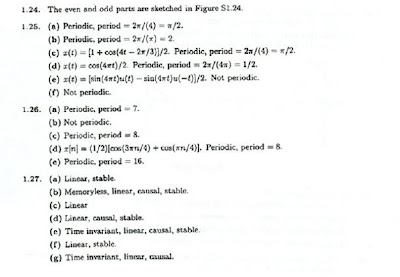These are the topics about chapter 1:
Continuous-tlime and Discrete-Time Signals
Examples and Mathematical Representation
Signal Energy ant: Power
Transformations of the Independent Variable
Examples of Transformations of the Independent Variable
Periodic Signals
Even and Odd Signals
Exponential and Sinusoidal Signals
Continuous-Time Complex Exponential and Sinusoidal Signals
Discrete-Time Complex Exponential and Sinusoidal Signals
Periodicity Properties of Discrete-Time Complex Exponentials
The Unit Impulse and Unit Step Functions
The Discrete-Time Unit Impulse and Unit Step Sequences
The Continuous-Time Unit Step and Unit Impulse Functions
Continuous-Time and Discrete-Time Systems
Simple Examples of Systems
Interconnect:ons of Systems
Basic System Properties
Systems with and without Memory
Invertibility and Inverse Systems
Causality
Stability
Time Invariance
Linearity
Signal Energy and Power
From the range of examples provided so far, we see that signals may represent a broad variety of phenomena, In many, but not all, applications, the signals we consider are directly related to physical quantities capturing power and energy in a physical system.
TRANSFORMATIONS OF THE INDEPENDENT VARIABLE
A central concept in signal and system analysis is that of the transformation of a signal. For example, in an aircraft control system, signals corresponding to the actions of the pilot are transformed by electrical and mechanical systems into changes in aircraft thrust or the positions of aircraft control surfaces such as the rudder or ailerons, which in turn are transformed through the dynamics and kinematics of the vehicle into changes in aircraft velocity and heading. Also, in a high-fidelity audio system, an input signal representing music as recorded on a cassette or compact disc is modified in order to enhance desirable characteristics, to remove recording noise, or to balance the several components of the signal (e.g., treble and bass), In this section, we focus on a very limited but important class of elementary signal transformations that involve simple modification of the independent variable, i.e., the time axis. As we will lee in this and subsequent sections of this chapter, these elementary transformations allow us to introduce several basic properties of signals and systems.









Subscribe to:
Post Comments (Atom)
0 yorum
Post a Comment